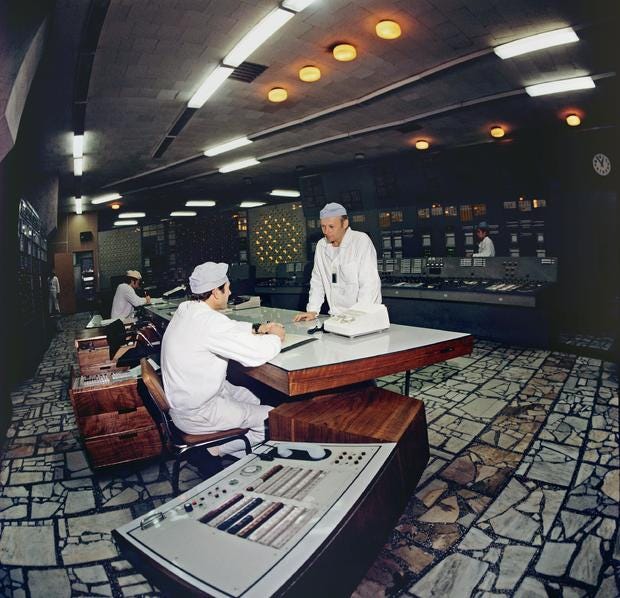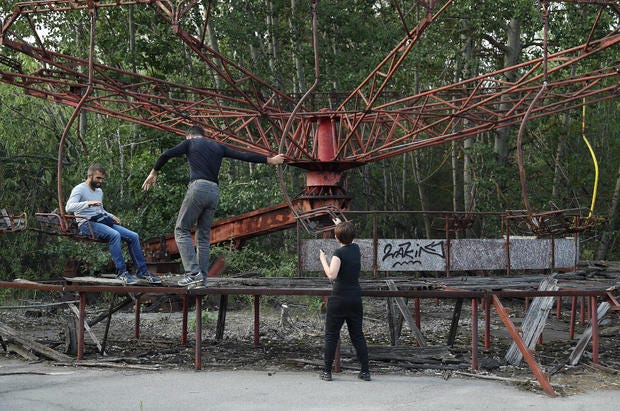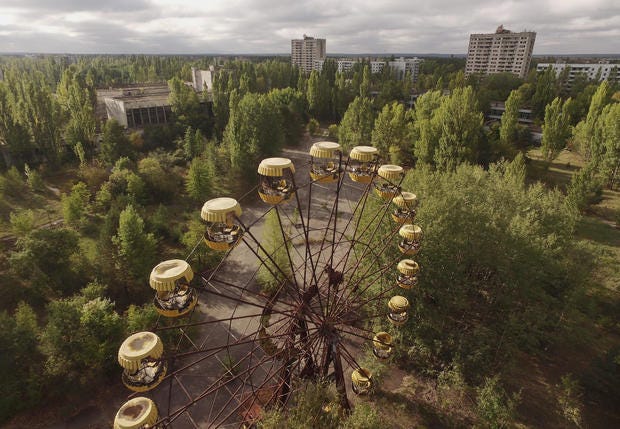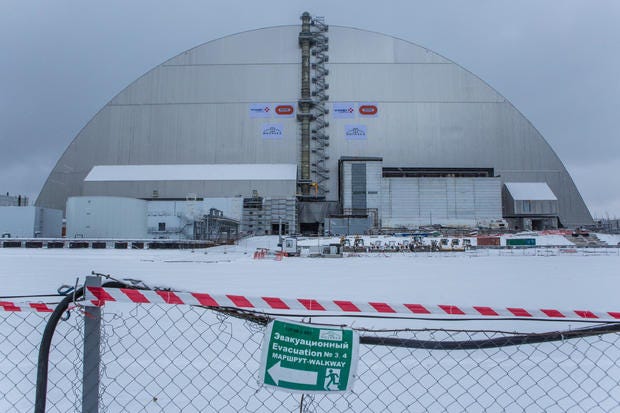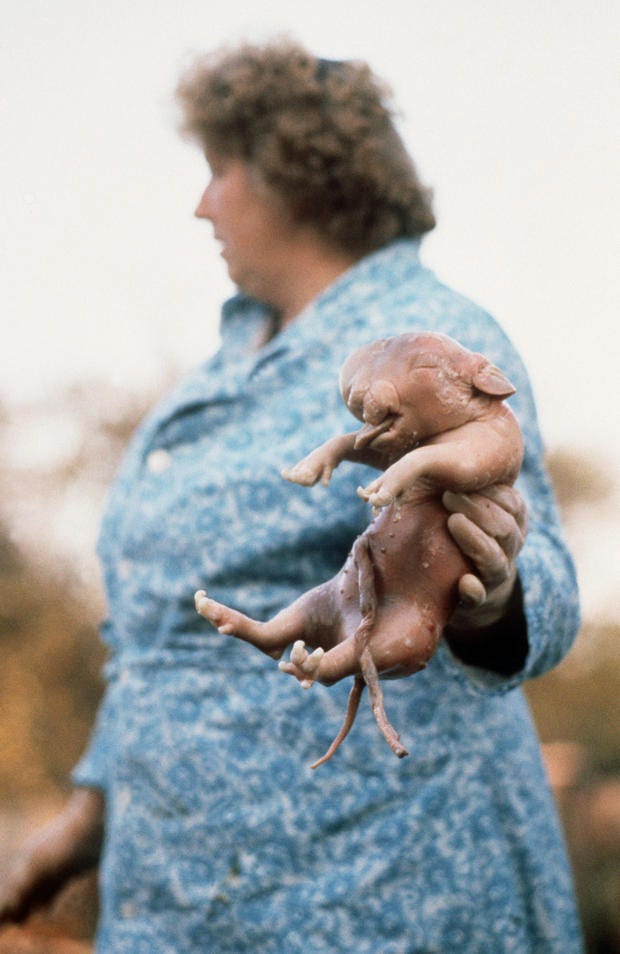Pictured above: the control desk at the Chernobyl plant days before the disaster
April 25, 1986
1am
Operators at the plant reduced power for reactor number 4 to prep for a safety test, which was timed to coincide with a routine shutdown for maintenance
The test was to determine whether or not still-spinning turbines can produce enough electricity to keep coolant pumps running during a gap before emergency generators kick in if there were a power failure
This test by itself eventually brings the reactor’s destruction
2pm
Reactor number 4’s emergency cooling system was disabled to keep it from interfering with the test (this leads to a worsened impact)
The test and the shutdown were temporarily delayed to accommodate the regions power needs
11:10pm
Operators receive permission to continue with the test and shutdown
By this point, less-experienced night shift were on the job
This shift was noted to have never been properly trained to perform such a test
April 26, 1986
12:28am
The power plummets to a point far below the level at which the reactor would be considered as stable
Operators respond by removing most of the control rods, although this is in violation of plant’s safety guidelines
They still have trouble raising the power, partly due to Xenon buildup in the core
1am
Power then stabilizes, but the level is lower than preferred
Plant supervisors order workers to proceed with the test
Auto-emergency shutdown system and other safety features are subsequently turned off
1:23:04am
Test is officially started, and an unexpected power surge occurs
1:23:40am
An operator presses the emergency shutdown button, but control rods jam while entering the core
1:23:58am
The first explosion happens, which is followed by at least one more explosion
This explosion blows the 1,000 ton roof right off the reactor and shoots a fireball into the night sky
There is a blackout, the plant air fills with dust and graphite chunks and radiation
The walls and equipment collapse, dozens of fires start, including one on top of the neighboring reactor
Despite all the evidence showing otherwise, the nuclear engineer in charge of the test insists that reactor number 4 was still in tact
This engineer later died of radiation poisoning
1:28am
The first firefighters arrived, they do not have knowledge of the radiation, and wear no protective clothing
2:15am
Local soviet officials convene in an emergency meeting, they decide to block cars from exiting or entering Pripyat, which was a nearby city that was built to house Chernobyl employees and their families
Police assisting with the roadblock also had no knowledge of the radiation and wear no protective clothing
5am
Officials shut down reactor number 3, to be followed the next morning by reactors 1 and 2, which were reopened months later
6:35am
By now, all fires had been extinguished, except for a blaze in the reactor core, which burned for days
Pictured above: an abandoned marry-go-round in Pripyat
April 27, 1986
10am
Helicopters begin dumping sand, clay, boron, lead and dolomite into the burning core, attempting to slow radioactive emissions
2pm
After telling residents nothing about the disaster for 36 hours, soviet officials finally begin evaluating roughly 115,000 people from Pripyat, as well as nearby towns and villages
Residents are then informed that it will only be temporary and that they should pack only vital documents and belongings, plus some food
Soon after, an exclusion zone set up around Chernobyl that prevents their return
April 28, 1986
Swedish air monitors detect a large amount of radiation in the atmosphere which is traced back to the USSR
Soviet officials admit that there’s been an accident, but state that the situation is under control, even though that is not true
April 29, 1986
A spy satellite takes photos that provide US officials with their first glimpse of the devastation wrought by the Chernobyl disaster
Pictured above: an abandoned Ferris wheel in Pripyat
May 1, 1986
Soviet officials refuse to cancel the May Day festivities in Kiev, even as radiation continued to be released, unabated
May 4, 1986
Liquid nitrogen is pumped under the reactor in order to cool it
Liquidators also bulldozed contaminated villages, contaminated animals were shot, regardless of whether they were pets or livestock, contaminated topsoil was buried
May 6, 1986
Radioactive emissions drop sharply, possibly because the fire in the core burned itself our
Soviet officials finally close schools in Kiev and advise residents to stay inside and not to eat leafy vegetables
May 8, 1986
Workers finish draining about 20,000 tons of radioactive waste from the basement under the core
May 9, 1986
Workers begin to pour concrete under the reactor, later encased in an enormous concrete and metal structure, which is now known as “The Sarcophagus”
Pictured above: The New Safe Confinement Sarcophagus
May 14, 1986
President Gorbachev speaks publicly about the incident for the first time and claims, “the worst part is behind us”
August 25-29, 1986
The International Atomic Energy Agency (IAEA) hosted a conference at which scientists blame the accident not just on human error, but also a subpar safety culture, but also on the design of the reactor
Pictured above: a deformed pig born in the CEZ
December 15, 2000
Unit 3, which was the last working reactor, is shut down
Units 1 and 2 had been shut down in 1991 and 1996
April 2006
Former President Gorbachev writes that the Chernobyl disaster, “even more than the launch of Perestroika, was perhaps the real cause of the collapse of the Soviet Union”
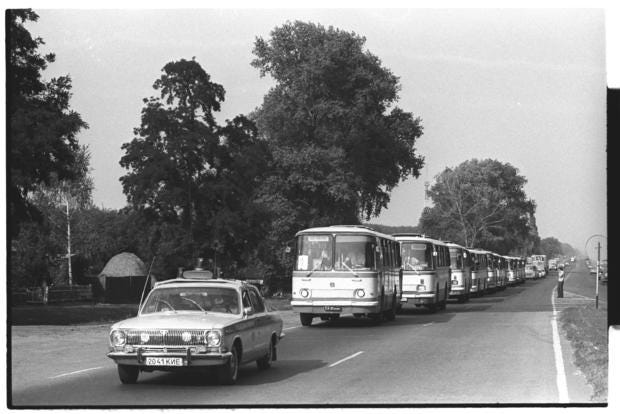
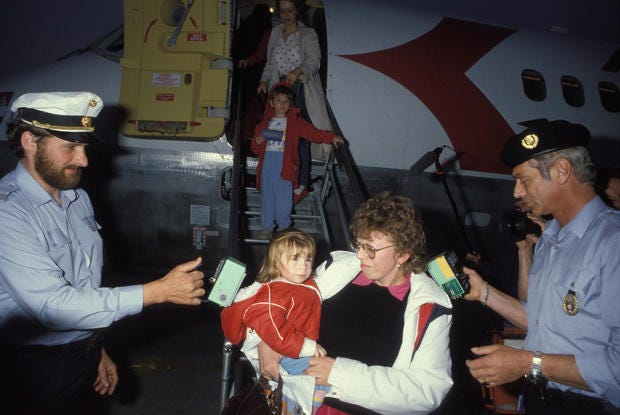
Pictured above: buses carrying 49,000 evacuees and refugees being checked for radiation while exiting a plane
Effects After
The disaster resulted in the deaths of 30 operators and firemen within three months. One person was killed immediately in the explosion, and a second died in the hospital soon after due to the injuries. 237 people were originally diagnosed with Acute Radiation Syndrome, 134 cases were later confirmed. 28 people died of ARS within a few weeks of the disaster.
Nobody offsite suffered from ARS, but a significant, however uncertain, fraction of thyroid cancers have been diagnosed since in people who were children between the ages of 0 and 14 who were living in the area at the time, likely due to iodine fallout.
Large areas of Belarus, Ukraine, Russia and beyond were contaminated in varying degrees. It is known as the only accident in history of a commercial nuclear power plant where radiation-related fatalities occurred. This led to major changes in safety culture and in industry cooperation. During the time of the accident, two more RBMK reactors were being constructed.
Pictured above: an abandoned hospital in Pripyat
The area of Pripyat had about 49,000 inhabitants, and old town Chornobyl had a population of 12,500. Within a 30 kilometer radius, the population was about 115,000 at the time, and all those people were evacuated using 1,200 buses and two trucks. It is estimated all of the xenon gas, half of the iodine and cesium, and at least 5% of the remaining radioactive material in the number 4 reactor was released. The number 4 reactor had 192 tons of fuel. The contaminants were mostly deposited close by as dust and debris, lighter materials were carried by wind over Ukraine, Belarus, Russia and to some extent over Scandinavia and Europe. There were at least 1,800 documented cases of thyroid cancer in the incident, which is far higher than normal rates. The psychological effects of Chernobyl were, and remain, widespread and profound-resulting in instances in suicides, drinking problems, and apathy.
Leaves on trees in the area changed shape and some animals are still born with physical deformities. To this day, children are not allowed to live in the exclusion zone. The CEZ is now the 3rd largest nature preserve in mainland Europe, and it also serves as an accidental experiment in re-wilding after nuclear fallout. Plants are still dangerous to eat when grown in radioactive soil. Wolf populations are seven times higher than before the accident happened. Przewalski’s horses were declared as extinct in the wild (meaning all populations left were bread and lived in captivity,) in the 1960s. However, when some of these horses bread in captivity were introduced to the CEZ area, the population thrived and increased to over 200 horses. These populations are believed to be sustainable and possibly grow for several more generations.
Pictured above: a Przewalski’s horse outside an abandoned building in the CEZ
However, when Russian troops invaded Ukraine on February 24th, 2022, they did so through the CEZ. They occupied the immediate surrounding area for over five weeks, which caused about $54 million in damages to the CEZ and the NSC. During this time, Russian troops not only looted the offices in the plant, they also cut power to the reactor which made the cooling of the deteriorating nuclear material unreliable which could lead to a nuclear fallout issue in the future. While the damage to the CEZ is not permanent and is repairable, it is still very considerable. The scariest part of the damage is that we now do not know if the nuclear material will now lead to an issue in the future.
Satellite images of Russian military vehicles moving along the road outside of Chernobyl a day after Russia launched its invasion of the Ukraine
I hope you’ve learned something from this article. I know I did. It’s truly scary what nuclear fallout can mean. It’s dangerous and very interesting that we haven’t found a cleaner, less risky way to create and store energy. It’s also very interesting that it has been made into a nature preserve that seems to be doing very well! My next article will be about The Battle of Los Angeles! Was it aliens? Or overreaction? Let’s see! Tune in next time.
Sources:



